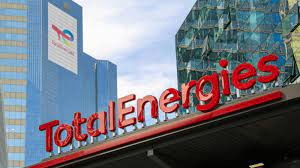

France’s energy giant, TotalEnergies has made a final investment decision (FID) for a liquefied natural gas (LNG) project in Oman, designed to run on solar power and serve as the first LNG bunkering hub in the Middle East. This gas project showcases the French player’s multi-energy strategy in action, combining fossil fuel production with renewable energy generation, enabling LNG and solar to tie the knot.
The FID for the Marsa LNG project was revealed during a visit to Muscat on April 21 by TotalEnergies’ Chairman and CEO and Mulham Basheer Al Jarf, Chairman of OQ, Oman’s national oil company (NOC). During this visit, the French oil major’s CEO met with Sultan Haitham bin Tariq Al Said and Salim bin Nasser Al Aufi, Oman’s Minister of Energy and Minerals.
Aside from signing a sale and purchase agreement (SPA) with Oman LNG to offtake 0.8 Mtpa of LNG for ten years from 2025, TotalEnergies (49%) and OQ Alternative Energy (51%), the national renewable energy champion, confirmed being at an advanced stage of discussions to jointly develop a portfolio of up to 800 MW, including the 300 MWp solar project that will supply Marsa LNG.
Through their joint company, Marsa Liquefied Natural Gas (Marsa), TotalEnergies (80%) and OQ (20%) sanctioned the integrated Marsa LNG project which combines upstream gas production, downstream gas liquefaction, and renewable power generation.
In line with this, 150 Mcf/d of natural gas, coming from the 33.19% interest held by Marsa in the Mabrouk North-East field on onshore Block 10 will provide the required feedstock for the LNG plant. While Block 10 production started in January 2023 and reached a plateau in April 2024, the FID allows Marsa LNG to extend its rights in Block 10 until 2050.

Furthermore, a 1 Mt/y capacity LNG liquefaction plant will be built in the port of Sohar, with the LNG production start-up anticipated by 1Q 2028. This LNG is primarily intended to serve the marine fuel market in the Gulf while the quantities not sold as bunker fuel will be off-taken by TotalEnergies and OQ. In addition, a dedicated 300 MWp PV solar plant will be built to cover 100% of the annual power consumption of the LNG plant.
TotalEnergies believes that this enables a significant reduction in greenhouse gas emissions, as the Marsa LNG plant will be 100% electrically driven and supplied with solar power, positioning the site as one of the lowest GHG emissions intensity LNG plants ever built worldwide, with a GHG intensity below 3 kg CO2e/boe. As the average emission intensity of LNG plants is around 35 kg CO2e/boe, this project represents a reduction in emissions of more than 90%.
Moreover, the main engineering, procurement, and construction contracts have been awarded to Technip Energies for the LNG plant and CB&I for the 165,000 m3 LNG tank. The operator claims that the Marsa LNG project is set to generate long-term employment opportunities and significant socio-economic benefits for the city of Sohar and the region.
Patrick Pouyanné, Chairman and CEO of TotalEnergies, commented: “We are proud to open a new chapter in our history in the Sultanate of Oman with the launch of the Marsa LNG project, together with our partner OQ, demonstrating our long-term commitment to the country. We are especially pleased to deploy the two pillars of our transition strategy, LNG and renewables, and thus support the Sultanate on a new scale in the sustainable development of its energy resources.
“This very innovative project illustrates our pioneer spirit and showcases the relevance of our integrated multi-energy strategy, with the ambition of being a responsible player in the energy transition. By paving the way for the next generation of very low emission LNG plants, Marsa LNG is contributing to making gas a long-term transition energy.”
With the ambition of the Marsa LNG project to serve as the first LNG bunkering hub in the Middle East, TotalEnergies highlights that this spotlights an available and competitive alternative marine fuel to reduce the shipping industry’s emissions. The firm underlines that LNG helps to cut greenhouse gas emissions by up to 23%, nitrogen oxide emissions by up to 85%, sulfur emissions by 99%, and fine particle emissions by 99%, compared to conventional marine fuel.
During 1Q 2024, TotalEnergies’ production in Oman was 61 kboe/d. The company produces oil in Block 6 (4%), natural gas in Block 10 (26.55% via Marsa LNG LLC) as well as LNG through its participation in the Oman LNG (5.54%)/Qalhat LNG (2.04% via Oman LNG) liquefaction complex with an overall capacity of 11.4 Mtpa. The French giant is also conducting exploration activities in Block 12 (50%, operator), and is appraising Block 11 (22.5%).
With a global portfolio of 44 Mt/y in 2023, TotalEnergies is believed to be the world’s third-largest LNG player and its ambition is to increase the share of natural gas in its sales mix to 50% by 2030 to curb carbon emissions and eliminate methane emissions associated with the gas value chain while promoting the transition from coal to natural gas.
“Marine LNG sharply reduces emissions from ships and significantly improves air quality, in particular when at berth, for the benefit of port cities and communities in coastal areas. Used as a marine fuel, LNG helps to cut greenhouse gas emissions by up to 23% compared to conventional marine fuel and has the potential to reduce emissions significantly more if bio or synthetic LNG is used. As such, marine LNG is a sustainable, affordable and immediately available way of reducing emissions in the shipping sector,” elaborated TotalEnergies.
The company has actively invested in LNG bunkering infrastructure to support its shipping customers’ adoption of LNG as a marine fuel, deploying three LNG bunker vessels: the Gas Agility at the Port of Rotterdam, Netherlands, the Gas Vitality at the Port of Marseille-Fos, France, and the Brassavola at the Port of Singapore.—World Maritime News




